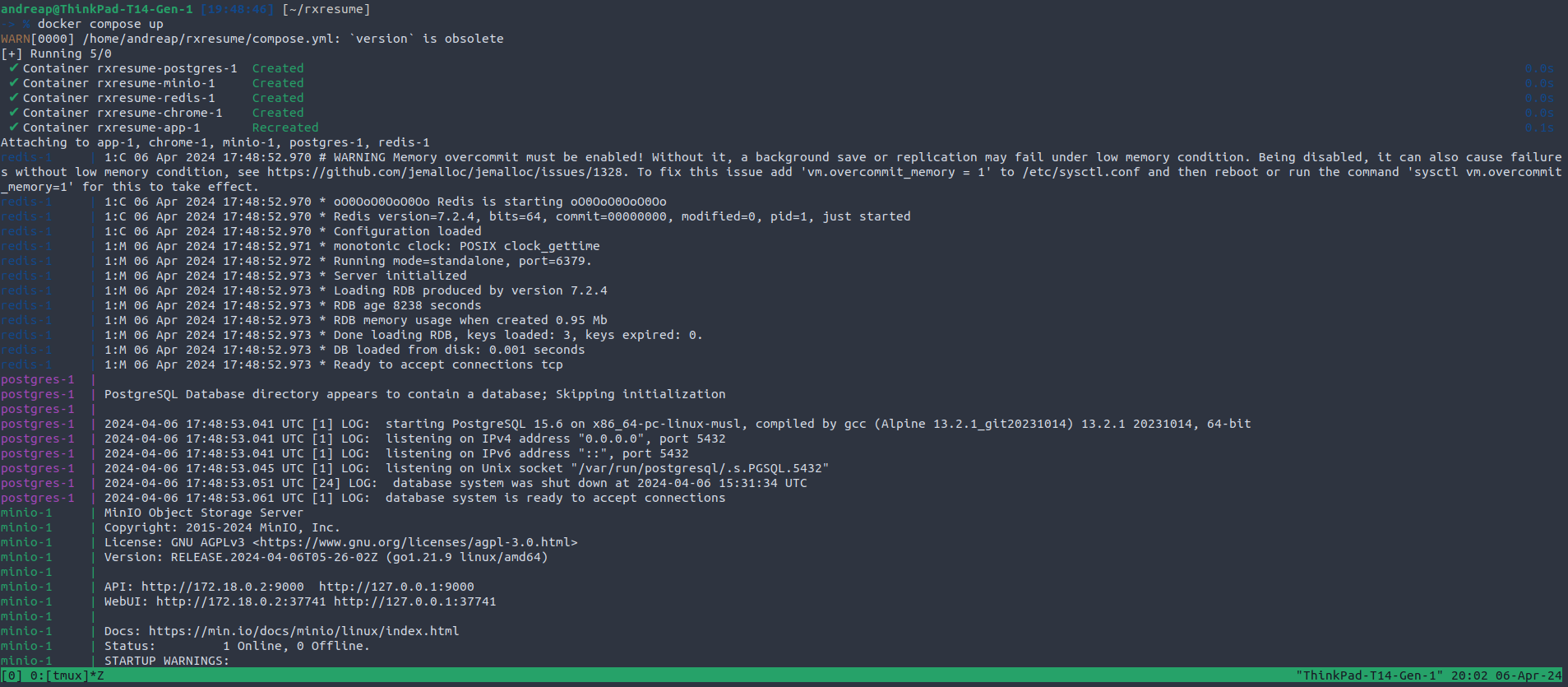How to Build a Good Resume for Free

In today's competitive job market, a well-crafted resume is the key to getting that first interview. A resume isn't everything, but it's what gets you from the screening stage to the first interview with the recruiter. There are plenty of resume builders available online, however most of them are not free or just have a free trial period of 14 days, and today I want to prove that there are excellent free alternatives out there.
Reactive Resume / Rx Resume
Reactive/Rx Resume is a free and open-source resume builder that simplifies the process of creating, updating, and sharing your resume.
You can either use the online version or the docker version that you can self-host on your web server or spin up locally to build your resume.
On the Rx Resume GitHub repository you can find a simple yaml file to deploy the stack locally with docker compose:
wget https://raw.githubusercontent.com/AmruthPillai/Reactive-Resume/main/tools/compose/simple.yml -O compose.yml && docker compose up

Visit localhost:3000 to set up your account

And now you're ready to start building your resume:

Important Note: Don't forget to export it as json to be able to re-import it later when you need to update it.
OpenResume
OpenResume is a more lightweight resume builder than the previous one. You can also use the online version or run it with its docker version:

Overleaf (LaTeX)
If you're already familiar with LaTeX, fantastic!
If not, and you're pressed for time, you can learn LaTeX later and consider the two previous resume builders. LaTeX is a typesetting system that offers extensive customization, while Overleaf functions as the Google Drive equivalent for LaTeX documents.
The Templates
On Overleaf you have plenty of CV/Resume templates available (https://www.overleaf.com/latex/templates/tagged/cv):

Pick a template and start building your own resume:

My Methodology
- Focus on the Content - While a visually appealing layout is essential, the content of your resume is what truly matters. Tailor your resume to the specific job you're applying for, highlighting relevant skills, experiences, and achievements.
Draft a brief introduction, no more than three lines for introducing yourself, your job experiences, skills, and education. Consider creating multiple versions of your resume.
The only parts that need adjustment are the introduction and the skills section, while the rest like job experiences and education remain constant.
For instance, if you're applying for a pentest job, emphasize your red team skills. For a security engineer role, focus more on blue team skills. And for a threat analyst position, adapt your skills to include expertise in threat intelligence analysis and DFIR. Maintain clarity and brevity in your language. Start by writing down all pertinent information, then refine it through iterative reviews to include only the most essential details. - Highlight Your Achievements - List your job duties and emphasize your accomplishments in each role. Quantify if possible to demonstrate your impact. Employers are more interested in what you've achieved than just what you've done.
- Utilize Action Verbs - Start each bullet point with a strong action verb to describe your responsibilities and accomplishments. Words like "achieved," "implemented," "managed," and "developed" can help convey your proactive approach and leadership abilities. Mix structured sentences with keywords to keep your message concise and relevant.
- Include Keywords - Many companies use applicant tracking systems (ATS) to screen resumes for relevant keywords. To increase your chances of passing through these systems, incorporate keywords from the job description into your resume. However, ensure that the keywords are naturally integrated and relevant to your experience. And if you can't, try to insert them within a hidden section to be only scanned by the ATS, it is quite ugly if you have a paragraph of keywords.
- Choose the Right Template - Once you are okay with the content, you can select a clean, minimal and professional resume template. You need a visually appealing layout.
- Proofread - Spelling or grammatical errors can make a negative impression on potential employers. Carefully proofread it multiple times.
- Seek Feedback - Seek feedback from people among your field, it can be peers or recruiters. Not all feedback is necessary relevant (don't ask your mom who is not into computers).
In conclusion, building a good resume is not that difficult. Your resume needs to be maintainable and adaptable. By following these tips and leveraging the free resources I've shared, you can create a compelling resume that effectively showcases your skills and experiences. With perseverance and attention to detail, you'll be well on your way to securing your next job.
Extra Tip: If you think your profile isn't strong enough for the job, let's say you're a security engineer aiming for a pentesting role, consider including a cover or motivation letter with your application. Recruiters often refer to the cover letter when they have doubts about a candidate's suitability. Many applicants for senior positions include a cover letter, so it's worth the time investment to research the job thoroughly. Your cover letter can be as short as five lines, focusing on why you're applying for the job and what motivates you.
Member discussion